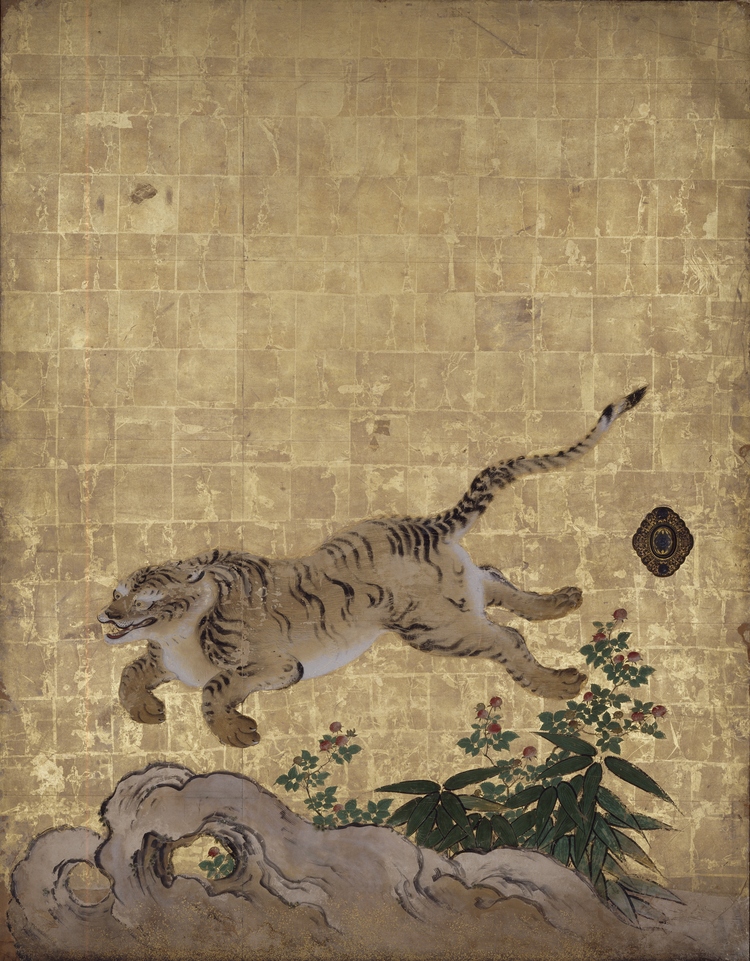Rikumo Field Trip: Kano Art at the Philadelphia Museum of Art
On a crisp Friday morning we took a break from preparations for the Flower Show and went on a field trip to the Philadelphia Museum of Art’s “Ink and Gold: Art of the Kano” exhibit for some much needed inspiration. We weren't disappointed: with its magnificent usage of gold and impeccable craftsmanship, it’s easily one of the most dazzling rare collections the museum has ever presented. This special exhibition runs February 16 to May 10, 2015, and features works by members of the Kano school, painters-in-residence to the Tokugawa shoguns, and one of the most famous schools of Japanese painting. Popularized in the late 15th century by the artist Kano Tan’yū (1602-1674), this exhibit showcases more than 120 works from this 400-year family legacy, making the Philadelphia Museum of Art the first to collectively present their masterpieces outside of Japan.
1. Tigers in a Bamboo Grove (Tigers at Play) (detail), mid-1630s. Kano Tan'yu, Japanese 1602-1674. Photo courtesy of the Philadelphia Museum of Art.
2. Bishamonten Pursuing an Oni, circa 1885. Hashimoto Gaho, Japanese, 1835-1908. Ink and color on paper, mounted as a hanging scroll. Photo courtesy of the Philadelphia Museum of Art.
Although gold has always been a universal sign of wealth across all cultures, during the fifteenth century it served a political purpose in Japan. It was the age of the shoguns, powerful military generals who took over Japan’s government and administration after the fall of the emperor in 1603. As a new ruling class, the shoguns had to establish a powerful image that would legitimize their right to rule. While the emperor had mythology and a few thousand generations supporting his claim, the shoguns used art to elevate themselves to the same position of power. They commissioned the Kano school, by this time an established dynasty of artists, to produce lavish works painted with gold to decorate their castles and homes. In this way, Kano art became not only the official art form of Japan, but also a way to showcase personal power. Traditionally, shoguns would receive guests in their castles standing before grand Kano screens with powerful, symbolic images, and in that way communicated the values a particular shogun stood for. When a shogun stood before a massive screen featuring Chinese lions, for example, he would communicate his own power and masculinity. When he stood before a harvesting scene, he showed the prosperity that Japan enjoyed under his rule. Art then became a way for the ruling class to identify themselves with power and magnificence.
Chinese Lions, late 16th century. Kano Eitoku, Japanese 1543-1590, Photo courtesy of the Philadelphia Museum of Art.
Ink and Gold is composed of a beautiful collection of decorative folding screens, fans, albums, doors, and scrolls depicting landscapes, the four seasons, scenes from prosperous daily life under the commissioning shogun, and the sea, which recalls Japan’s identity as an island nation. The technique requires a master hand: although the pieces look painted, they are actually composed of thin square pieces of gold foil laid upon paper or wood, which create a vivid contrast against the paint and ink. The usage of gold leaf also shows the craftsmanship and artistic skill of Kano artists –it is a challenging medium to paint with, since you cannot paint over mistakes –and the results are stunning. The usage of gold leaf also creates an interesting relationship between positive and negative space in Kano artwork: while some folding screens use gold to depict dimension in the form of clouds, others simply use a golden background to show flat space. True to traditional Japanese living, most of the action in these works is found towards the bottom, since screens were intended to be viewed while sitting down.
Pawlonia and Pines with Phoenix, circa 1802-1816. Kano Isen'in Naganobu, Japanese, 1775-1828. Photo courtesy of the Philadelphia Museum of Art.
Notably, the collection holds one work by a woman artist: a decorative scroll depicting the Queen of the West (a figure of Chinese mythology) by Kiyokara Yukinobu, a member of the Kano family trained in the technique. The museum also offers small glimpses into the Kano school’s artistic process by displaying albums made by Kano Tan’yū to preserve the artwork of earlier masters for copying and learning. Perhaps most telling is the last room of the exhibit, which shows the evolution of the Kano revival in the nineteenth century: brighter colors and new European techniques like foreshortening hint at a growing cultural bridge between Europe and Japan.
The last painting in the exhibit is a fitting send-off: two entwining dragons of different ages, symbolizing the passing of knowledge to a new, younger generation of artists. As curator Felice Fischer explains in this video, “This is the art and art history of Japan all in one comfortable, beautifully painted package.”
“Ink and Gold: Art of the Kano” runs from February 16 to May 10, with free tours every Wednesday, Friday, Saturday and Sunday at 11:00am and 1:00pm. Exhibit is free with admission. Due to their light sensitivity, works in the exhibition will be presented in three rotations which will change approximately every four weeks. The rotation schedule is February 16–March 15, March 18–April 12, and April 15–May 10, 2015.
WORDS BY MAGALI ROMAN
PHOTOGRAPHY COURTESY OF THE PHILADELPHIA MUSEUM OF ART




